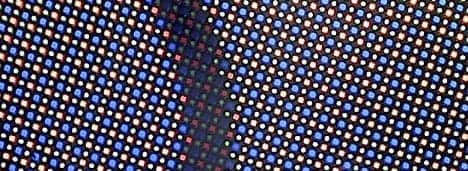We face lots of screens and displays today, starting with computer monitors, TVs, and smartphones and ending with more sophisticated virtual reality (VR) displays like Oculus Rift. Most of them already use high-resolution displays. For instance, Ultra HD 4k displays are becoming more and more available in the list of monitors. But what does this mean, and is this enough or too much? Many tests and debates are running about proper screen resolution when you have good picture quality and not waste only numbers. This is not what are we are going to discuss. Everyone has to find their own optimal solution. Why not do this rationally instead of chasing numbers.
Fig. 1 Screen door effect
From the practical side, resolution alone doesn’t have significant meaning when choosing screens and displays. You could take the other two parameters into account – distance from screen and screen size. All those parameters go along with human visual acuity – the smallest thing he can spot. When you go to the eye inspection, you are given a character chart to point to the smallest symbols you can see. The number next to that line represents your visual acuity. For healthy people, the parameter is 6/6 (20/20 in feet), which means that the eye can normally discern 1.75 mm objects from 6 meters. Wiki has a great explanation of acuity parameters. The best-recorded acuity was 6/3. For simplicity, we will use a decimal scale where 6/6 acuity is expressed as 1.0 value where 0.1 would mean the top line of the acuity test chart.
Fig. 2 Visual acuity test chart (source)
We can understand standard visual acuity 6/6 (or 20/20) as the ability to discern two points per single arc minute angle (as you may know – one arc minute is 1/60 of degree). To make things simple, we need to relate screen resolution, distance from the screen, and screen size to viewing angle, and then we can have a convenient way of finding the best resolution for your needs.
Fig. 3 Pixel size compared to visual acuity 1.0
Example 1: Take your standard 23” Full HD (1920 x 1080) monitor screen. You are sitting about 70 centimeters from it. Simplified screen height and width would be 29 X 51 cm. The first thing we need to do is calculate the monitor’s viewing angle. For this, we need to find arctangent of half screen width and distance ratio: a = 2*arctan(14.5/70) = 24 degrees. Now we can calculate how many pixels we get for a one-arc minute angle: p = 1080 / 24 / 60 = 0.75. So we get less than one pixel when we need at least a single pixel. Seeing this, we can assume that a 4K (2160) monitor would make a difference leaving us with 1.5 pixels per arc minute.
Example 2: Now, let’s move to TV. Take the same Full HD TV 1080p resolution 32” screen. The screen’s height is about 50 cm, and we sit 3 meters away from the TV. By applying the same calculus, we get a viewing angle of 9.5 degrees. And for a one-minute arc, we get around 1.9 pixels. So we get more than enough from Full HD TV, and you don’t need Ultra HD TV unless you are sitting 1 meter away from it.
Example 3: Smartphones. Let’s take the LG L90 smartphone, which has a 4.7” 540×960 screen. We take width at 6.7 cm, and we look at it from a 25 cm distance. The viewing angle we get is 15 degrees. Then we can calculate pixels per arc min, which is 540 / 15 / 60 = 0.6. This is not enough to get a great experience. Take Full HD display, and we get 1.2 pixels per arc min for normal visual acuity. I’d say you don’t need more than a Full HD display (1920×1080) for your smartphone, and the higher is just wasting phone resources and your money.
Example 4: In the last example I would like to discuss is the Oculus Rift 2 display. This is where things get interesting. Its resolution per eye is 1920 x 1080. Their declared field of view is 100 degrees. So we can directly calculate the number of pixels for a single arc minute: 1080 / 100/ 60 = 0.18. Like 6 times more resolution (16k with a smallest axial resolution of 6480), we would need to get a clear picture in a virtual environment. Even 4K display will not be able to produce a natural feel. This is where small displays with very high resolution will come in handy. I can imagine the data stream these glasses will have to deal with.




